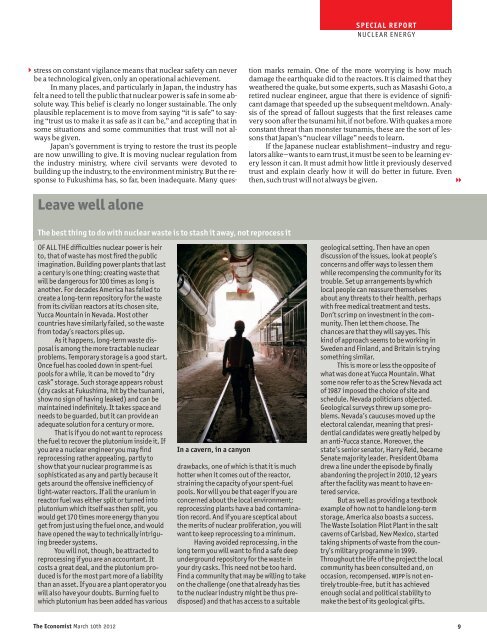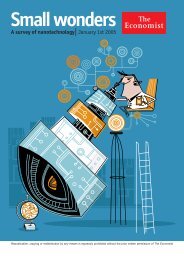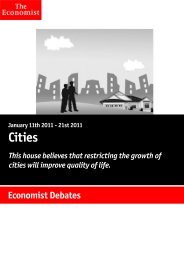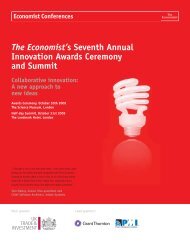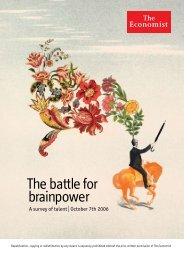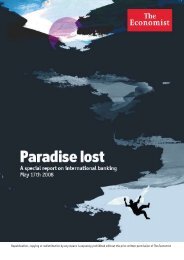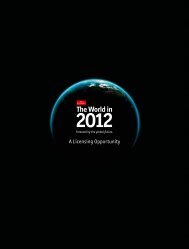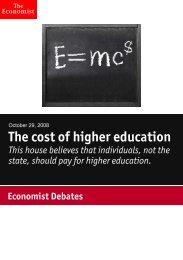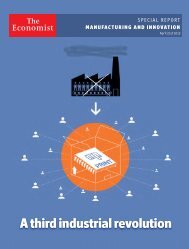The dream that failed
The dream that failed
The dream that failed
Create successful ePaper yourself
Turn your PDF publications into a flip-book with our unique Google optimized e-Paper software.
2<br />
stress on constant vigilance means <strong>that</strong> nuclear safety can never<br />
be a technological given, only an operational achievement.<br />
In many places, and particularly in Japan, the industry has<br />
felt a need to tell the public <strong>that</strong> nuclear power is safe in some absolute<br />
way. This belief is clearly no longer sustainable. <strong>The</strong> only<br />
plausible replacement is to move from saying it is safe to saying<br />
trust us to make it as safe as it can be, and accepting <strong>that</strong> in<br />
some situations and some communities <strong>that</strong> trust will not always<br />
be given.<br />
Japan’s government is trying to restore the trust its people<br />
are now unwilling to give. It is moving nuclear regulation from<br />
the industry ministry, where civil servants were devoted to<br />
building up the industry, to the environment ministry. But the response<br />
to Fukushima has, so far, been inadequate. Many ques-<br />
Leave well alone<br />
<strong>The</strong> best thing to do with nuclear waste is to stash it away, not reprocess it<br />
OF ALL THE diculties nuclear power is heir<br />
to, <strong>that</strong> of waste has most red the public<br />
imagination. Building power plants <strong>that</strong> last<br />
a century is one thing; creating waste <strong>that</strong><br />
will be dangerous for 100 times as long is<br />
another. For decades America has <strong>failed</strong> to<br />
create a long-term repository for the waste<br />
from its civilian reactors at its chosen site,<br />
Yucca Mountain in Nevada. Most other<br />
countries have similarly <strong>failed</strong>, so the waste<br />
from today’s reactors piles up.<br />
As it happens, long-term waste disposal<br />
is among the more tractable nuclear<br />
problems. Temporary storage is a good start.<br />
Once fuel has cooled down in spent-fuel<br />
pools for a while, it can be moved to dry<br />
cask storage. Such storage appears robust<br />
(dry casks at Fukushima, hit by the tsunami,<br />
show no sign of having leaked) and can be<br />
maintained indenitely. It takes space and<br />
needs to be guarded, but it can provide an<br />
adequate solution for a century or more.<br />
That is if you do not want to reprocess<br />
the fuel to recover the plutonium inside it. If<br />
you are a nuclear engineer you may nd<br />
reprocessing rather appealing, partly to<br />
show <strong>that</strong> your nuclear programme is as<br />
sophisticated as any and partly because it<br />
gets around the oensive ineciency of<br />
light-water reactors. If all the uranium in<br />
reactor fuel was either split or turned into<br />
plutonium which itself was then split, you<br />
would get 170 times more energy than you<br />
get from just using the fuel once, and would<br />
have opened the way to technically intriguing<br />
breeder systems.<br />
You will not, though, be attracted to<br />
reprocessing if you are an accountant. It<br />
costs a great deal, and the plutonium produced<br />
is for the most part more of a liability<br />
than an asset. If you are a plant operator you<br />
will also have your doubts. Burning fuel to<br />
which plutonium has been added has various<br />
In a cavern, in a canyon<br />
drawbacks, one of which is <strong>that</strong> it is much<br />
hotter when it comes out of the reactor,<br />
straining the capacity of your spent-fuel<br />
pools. Nor will you be <strong>that</strong> eager if you are<br />
concerned about the local environment;<br />
reprocessing plants have a bad contamination<br />
record. And if you are sceptical about<br />
the merits of nuclear proliferation, you will<br />
want to keep reprocessing to a minimum.<br />
Having avoided reprocessing, in the<br />
long term you will want to nd a safe deep<br />
underground repository for the waste in<br />
your dry casks. This need not be too hard.<br />
Find a community <strong>that</strong> may be willing to take<br />
on the challenge (one <strong>that</strong> already has ties<br />
to the nuclear industry might be thus predisposed)<br />
and <strong>that</strong> has access to a suitable<br />
SPECIAL REPORT<br />
NUCLEAR ENERGY<br />
tion marks remain. One of the more worrying is how much<br />
damage the earthquake did to the reactors. It is claimed <strong>that</strong> they<br />
weathered the quake, but some experts, such as Masashi Goto, a<br />
retired nuclear engineer, argue <strong>that</strong> there is evidence of signicant<br />
damage <strong>that</strong> speeded up the subsequent meltdown. Analysis<br />
of the spread of fallout suggests <strong>that</strong> the rst releases came<br />
very soon after the tsunami hit, if not before. With quakes a more<br />
constant threat than monster tsunamis, these are the sort of lessons<br />
<strong>that</strong> Japan’s nuclear village needs to learn.<br />
If the Japanese nuclear establishmentindustry and regulators<br />
alikewants to earn trust, it must be seen to be learning every<br />
lesson it can. It must admit how little it previously deserved<br />
trust and explain clearly how it will do better in future. Even<br />
then, such trust will not always be given.<br />
geological setting. <strong>The</strong>n have an open<br />
discussion of the issues, look at people’s<br />
concerns and oer ways to lessen them<br />
while recompensing the community for its<br />
trouble. Set up arrangements by which<br />
local people can reassure themselves<br />
about any threats to their health, perhaps<br />
with free medical treatment and tests.<br />
Don’t scrimp on investment in the community.<br />
<strong>The</strong>n let them choose. <strong>The</strong><br />
chances are <strong>that</strong> they will say yes. This<br />
kind of approach seems to be working in<br />
Sweden and Finland, and Britain is trying<br />
something similar.<br />
This is more or less the opposite of<br />
what was done at Yucca Mountain. What<br />
some now refer to as the Screw Nevada act<br />
of 1987 imposed the choice of site and<br />
schedule. Nevada politicians objected.<br />
Geological surveys threw up some problems.<br />
Nevada’s caucuses moved up the<br />
electoral calendar, meaning <strong>that</strong> presidential<br />
candidates were greatly helped by<br />
an anti-Yucca stance. Moreover, the<br />
state’s senior senator, Harry Reid, became<br />
Senate majority leader. President Obama<br />
drew a line under the episode by nally<br />
abandoning the project in 2010, 12 years<br />
after the facility was meant to have entered<br />
service.<br />
But as well as providing a textbook<br />
example of how not to handle long-term<br />
storage, America also boasts a success.<br />
<strong>The</strong> Waste Isolation Pilot Plant in the salt<br />
caverns of Carlsbad, New Mexico, started<br />
taking shipments of waste from the country’s<br />
military programme in 1999.<br />
Throughout the life of the project the local<br />
community has been consulted and, on<br />
occasion, recompensed. WIPP is not entirely<br />
trouble-free, but it has achieved<br />
enough social and political stability to<br />
make the best of its geological gifts.<br />
<strong>The</strong> Economist March 10th 2012 9<br />
1


